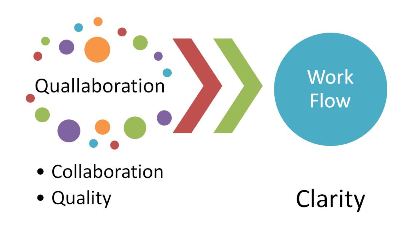Next week my podcast is on the subject of Quallaboration which is the relationship between Quality and Collaboration. Jim Benson, the person behind Personal Kanban was my guest and this is an excerpt from the upcoming podcast;
Joe: Talking about Quallaboration, I relate it somewhat to the Pair Programming that takes place in software development. Is it different then Pair Programming? Have you used it in your Quallaboration efforts?
Jim: Oh, you bet! Pairing is one of the things that I’ve taken out of programming, taken out of Agile and put everywhere I can. I found that the … because I’m so focused on Quallaboration, that Pairing is an amazing gift to long term productivity and to quality. I find that when people come together in a conference room and they decide “You go off and do this and I’ll go off and do this and then we’ll meet in a couple of days and then we’ll figure out what to do next.” When you meet together you achieve kind of this bubble of clarity. You understand what you’re supposed to do and the other person understands what they’re supposed to do. But you kind of understand it in context of your conversation. So, it’s this really bounded rationality, this world view that you have in the conference room that starts to dissipate the moment that you leave the classroom.
So, you start working on your tasks and another person starts working on their tasks and maybe you’re interacting with other people or you’re writing or whatever it is that you’re doing and you run into other variables and you start making decisions. The moment that you start making decisions, you’re definition of what you’re doing and the other person’s definition starts going off in other directions.
When you do Pairing, you maintain that focus, you’ve got more of an anchor to either what was decided immediately or you have a coalmine canary that can say, “Wait! I can feel deviation happening.” Because that deviation is just a natural way of working, so when you’re doing it alone you tend not to notice. The other thing that happens in Pairing is just a natural, constant quality checking. So 100%, well, maybe 95% of the Personal Kanban book was written with Pair writing using Google docs.
Tonianne is on one side of North America and I am on the other side of North America. We just sat there on Google docs and edited the same text all the way through the document. I’ve used it with the World Bank, with scientists working together. I’ve used it a UN project in Vietnam. I can’t say enough good things about getting two minds on something versus one.
Joe: When you walk out of a Kaizen event, you go on your own and start doing a task, I think you have a tendency to go back the way it was and what was easy for you. With that other person, you have accountability, that check and balance is there.
Jim: You can innovate as you’re rolling along, as you’re doing the work you can innovate. You innovate with somebody there who again is an anchor. So they can say, “Yeah that would be a really cool innovation. We should probably alert the others that we’ve done it. ” Or, “That’s a totally illogical innovation, let’s just run with it because it doesn’t impact anybody else.” But that check and balance of keeping you in line with the rest of the organization is there.
Joe: I look at the knowledge sharing and the cross training, what you’re doing with pairing is that you’re taking all the different things of collaboration, all the things that you spell out and you’re making it immediate. You’re making it something that happens in real time and you’re not doing it individually, you’re doing it with a group and that’s a huge key here, is that constant feedback really does make work continuous.
Joe: If you could only work on one thing with an organization, what would that be?
Jim: The notion of clarity which for me is at the center of Quallaboration and at the center of Personal Kanban. What I find is that people who were previously under-performing workers or teams that were previously under-performing tend to really take off when they know what they’re supposed to be doing, how they’re supposed to be doing it, how it fits into the company and what the ramifications are for different decisions they make in building it. Once they understand how they actually fit into the framework of the company, their design decisions noticeably, measurably improve. For me, there’s a couple of easy ways to do that. The easiest way is to use a visual control that just shows everybody all the time, what is happening in the group and to a lesser extent in the company as a whole.
That gives them the context that they need to act, to make better decisions and to build better product. I really feel like that is the thing that is most missing in teams. In every team that I’ve worked with where there’s been an issue is people were just hungry for information and getting them that information in a non?obtrusive way works miracles.
About Jim Benson: Jim incorporates his background in cognitive psychology, government, and management to build community through policy and technology. His company, Modus Cooperandi, helps organizations change through the application of Lean principles, Agile methodologies, and social media. He is also the developer of the productivity tool Personal Kanban, an adaptation of Industrial Kanban which helps individuals and small teams actualize. His book on Personal Kanban, which applies Lean thinking to daily living, will be out in Fall 2010.
Related Posts:
Marketing Kanban
Marketing Kanban Cadence
Agile, Scrum, Kanban, or is it just a Marketing Funnel?
Pull: The Pull in Lean Marketing


Comments are closed.